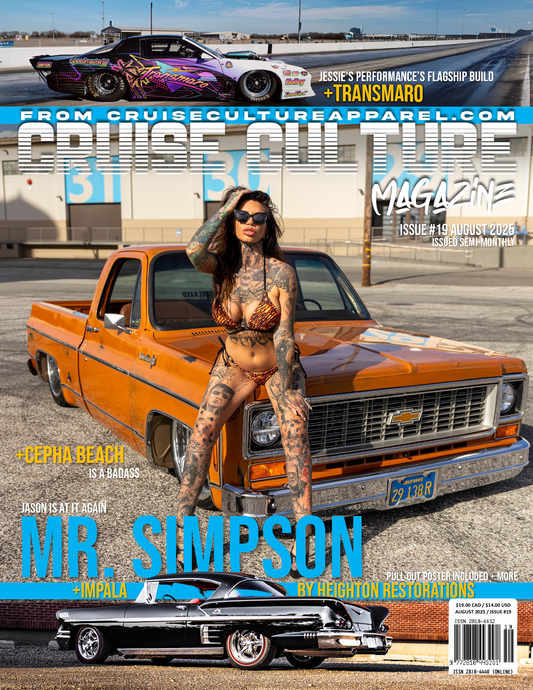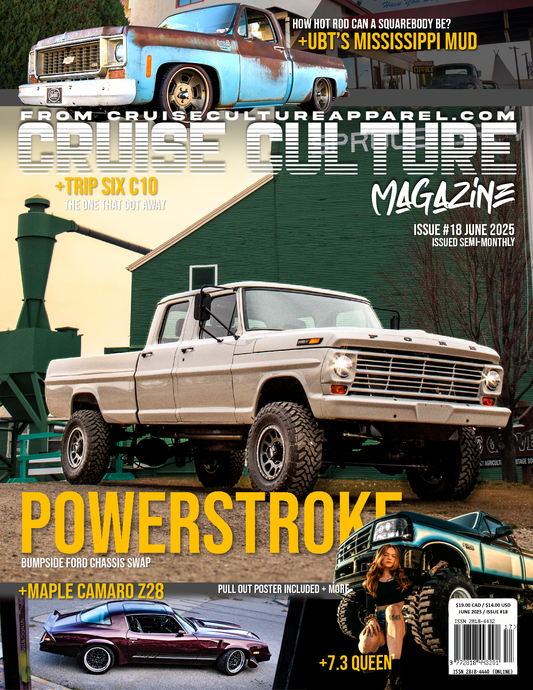Words and Photos by Ethan Vandervelden (Heathen's Garage)
“You’ve never built a street rod? Oh, you’ve had a race car? And you’ve had hot rods, and a few sports car, but never a streetrod”?
That’s the kind of conversation I’m on the receiving end of at car shows. I’ve just never been a “rods and customs” kind of guy. Then I met Brian. Like editor-in-chief of this magazine, Brian. Well, not really met, I watched his YouTube channel, and I was instantly hooked on the idea of cruising for the sake of cruising. I want something custom, old, awesome to drive, slammed to the ground, and truly unique. Also being a blue-collar kind of guy, the budget really matters.

My hunt began.
Enter one very particular 1950 Chrysler Desoto Custom.
Let’s start with the cost: I traded my inheritance for it.
Yep, that part is true. One, beautiful Gibson Les Paul guitar exchanged hands and I loaded the Desoto on the trailer. I’m sure my grandmother will understand, rest her soul.

So, what’s the build plan?
To be honest, I am wondering the same thing. As I stare at the looming amount of work it’s easy to feel a bit overwhelmed. My solution was to find the easiest dopamine faucet and turn it on, which for this car, was the woeful interior.

To say the car was “infested”, is putting it all too lightly. Unbearable, disgusting, horrific, miserable, vomit-inducing, and downright unpleasant would be more suitable. So, armed with a shop vac, a pressure washer, and a mask we set to work. The carpet (or whatever it may have had) was already removed but the seats and especially the headliner served as apartment buildings for the wretched vermin known as mice. Despite breaking six out of eight bolts on the way out, the seats are likely salvageable for someone with some skill; the headliner and roof insulation are a total loss and landed directly in the burn pit. Door cards are sadly trashed but have been left in place for now to be used as patterns in the future.

Twelve hours of swapping back and forth with the vacuum and the pressure washer yielded good progress and the interior no longer required a hazmat suit as part of the dress code. Overall, it felt like a good first step and gave me the much needed motivation to continue. That being said, it did hurt my heart to remove the once beautiful interior and expose all the rust we will need to patch up.

Next up, we yanked off the carburetor, gave it a cut-rate, no gasket required clean up, and tossed a new 6-volt battery in. My own misdiagnosis also added removing the starter four times to clean the brushes, but we aren’t going to talk about that. We cranked on the key and the old 237 six-in-a-row purred like a kitten. The transmission seems to be functional, but we haven’t had into high range just yet, given the fact we weren’t supposed to be driving on the road (more on that in a sec).

While a frame and drivetrain swap are definitely a plan in the works, it never sits well with me to say goodbye to a powertrain without getting acquainted. Here is the short version of the factory equipment as well as I know it.

The 237 cubic inch flathead straight six isn’t really that weird, crankshaft goes round and round, pistons go up and down. Points ignition, single barrel carb, nothing surprising at all. It’s the Fluid Drive emblem on the dashboard I’d never heard of.

Here is your hook; it’s got a clutch AND a torque convertor….ish.
Some Google searching along with an old shop manual that came with the car netted some information I will share for those interested. The transmission has 4 forward gears and 1 reverse, the shifter by appearances looks like a 3-on-the-tree, but the first gear position is locked out. Reverse is located towards yourself and up, low and high are away and up or down respectively. The clutch is used to select and change between the three positions, while the torque convertor/fluid coupling will slip during stops and take-off and no clutching is needed. The transmission automatically shifts from 1-2 and 3-4 as long as the speed is high enough and throttle pedal is released. It’s weird to drive.

Which brings us to the second stage of this project.
The Desoto was last registered in Saskatchewan, Canada. To get registration (essentially a “title”) for the streets of Alberta, the Desoto will require a (cringe), “Out of Province Inspection”. Meaning the car has been rigorously checked over by an approved shop and is safe for the road. Love it. Hate it. Whatever. It’s required. The easiest way to pass the “OOP” is with a bone stock car because it will only be required to meet the standards of the year of manufacture.

In short, the start of my custom, slammed, bad to the bone street rod will be to “restore it” completely original. Don’t worry, no patina will be harmed in the procedure, there are no rules regarding paint. Over the coming months, we will fix any rust we find, get the brakes and suspension up to 1950 standards, as well as get all of the 6-volt electrical niggles worked out. As soon as that is completed and the government takes their share, the modifying begins!

If you have suggestions for this build or want to voice what you would like to see, reach out @cruiseculturemagazine on all the social media platforms or email us at cruisecultureapparel@hotmail.com.
Also, if you happen to have a hood emblem for a 1950 Desoto custom…let me know, they’re like $400 bucks on eBay, that doesn’t seem very budget friendly.
Words and Photos by Ethan Vandervelden (Heathen's Garage) https://www.youtube.com/@heathensgarage
















